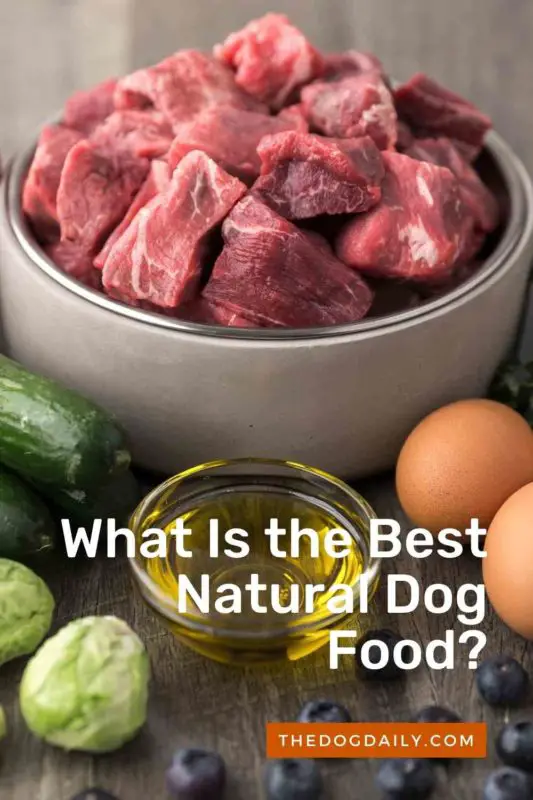What Is Natural Dog Food?
Vegan Amy Rader knows her dog, Henry, needs meat protein, but she hates that chemically processed additives are going into her 5-year-old Beagle’s food. The new “natural” label on pet foods — and what that precisely means — has also puzzled the Seattle-based social worker. “It’s similar to buying organic for myself,” explains Rader. “A lot of words that sound pretty good are on the packaging, but I’m not always sure exactly what they mean, and I end up spending way too long in the pet store.”
For dog owners like Carol Davis of Fairfax, Va., the sight of a synthetic or chemical ingredient listed on a pet food label leads to the following conclusion: I wouldn’t feed that to my dog. “I usually avoid it,” says Davis, who has a 5-year-old English Springer Spaniel named Lana. “I feel like if she eats healthy now, she’ll stay healthier, and we’ll have fewer vet bills later.”
Like Davis, you are probably more concerned about putting “natural,” or minimally processed, foods on your dinner table, and that standard now extends to what’s in Fido’s bowl. Davis says she looks for recognizable ingredients, such as chicken and carrots when choosing Lana’s commercial food. However, there’s still some confusion about what constitutes a “natural” dog food.
“Natural” Dog Food Labeling Rules
The Food and Drug Administration (FDA) and the Association of American Feed Control Officials (AAFCO) regulate dog food labeling in the United States. Companies can’t make claims about pet food products that are false. The FDA doesn’t define the term “natural” for the pet food industry. Still, the AAFCO definition says natural food is “… derived solely from plant, animal, or mined sources. It does not contain any additives or processing aids that are chemically synthetic except in amounts as might occur unavoidably in good manufacturing practices.”
Most commercial dog foods contain some synthetic sources of essential vitamins, minerals, and amino acids that meet AAFCO’s requirements that the food is “complete and balanced.” These requirements are to satisfy a dog’s nutritional needs, says Dr. Amy Dicke, DVM, a Dayton, Ohio-based veterinarian who has worked with teams of nutritionists and researchers. “If a product says it is all-natural and has not pulled out ‘with the inclusion of vitamins, minerals and amino acids,’ when in truth, they may not be practicing proper marketing,” Dr. Dicke says.
Dr. Katy Nelson, DVM, an emergency veterinarian in Virginia, suggests that Rader try a different approach when selecting dog food. “Do your research before you go to the pet store,” Dr. Nelson advises. “Labels are confusing. I’ve spent hours lecturing about them to veterinary students, and even they still have questions when I’m done!”
Below, Dr. Nelson explains current industry standards for natural kibble and weighs whether this food is right for your pet.
How the USDA Define Natural Dog Food
Believe it or not, the federal government has taken an interest in protecting pet food consumers from misleading claims. Like food for humans, food for dogs must adhere to the United States Department of Agriculture‘s definitions of “natural.” According to the USDA, food can only be labeled “natural” if it is minimally processed and contains no artificial ingredients or added colors.
Minimally processed can be fine, but sometimes that means it has no preservatives, so you need to be careful with expiration dates.” If it’s preservative-free, buy less of it. Ideally, you’d choose food containing natural preservatives like vitamin C and vitamin E rather than no preservatives at all.
How the AAFCO Define Natural Dog Food
The American Association of Feed Control Officials (AAFCO) provides a more specific description of the labeling requirements, adding that chemically synthesized ingredients may not be present in vittles claiming to be natural. Two common chemically synthesized ingredients in pet foods are propylene glycol and BHA. They both must be listed as ingredients on the labels of pet foods that contain them.
Ingredients in a “Natural” Dog Food
Protein
Dogs are classified as either carnivores or omnivores. Either way, they are best fed a diet high in animal protein. Meat and/or poultry sources — such as chicken, lamb, or eggs — should be listed within the first three ingredients in natural dog food, says Katy J. Nelson, D.V.M., an emergency veterinarian in Alexandria, Va., who has worked on dog nutrition.
Byproducts
This term has gotten a bad rap. Meat or plant-based byproducts fit the definition of “natural” under the AAFCO regulations. “Good, high-quality pet food byproducts don’t need to be a four-letter word,” Dr. Nelson says. Organ meat and tissue help provide dogs with needed minerals and amino acids.
Grains
Natural sources of carbohydrates, such as brewer’s rice, whole-grain barley, and ground whole grain sorghum, can provide energy for a dog’s active lifestyle, Dr. Dicke says.
Fruits and Vegetables
Spinach, tomatoes, and peas are rich in vitamin E and antioxidants to help your dog build its immunity; apples are a great source of fiber; carrots help keep your dog’s vision healthy.
No Added Artificial Colors, Flavors or Preservatives
“Natural” dog foods should not have synthetic fillers, artificial colors or flavors, or human-made preservatives. Natural flavors and colors are okay. Some preservatives are naturally occurring, such as vitamin E and tocopherols (TCP), acceptable to help preserve food.
Veterinarian Recommendations For Natural Dog Food
While Dr. Nelson sees the value in natural pet foods, she also advises dog owners to proceed with caution, keeping the following guidelines in mind:
- Remember that “natural” is not the same as “complete and balanced.” Ensure any pet food you select has conducted AAFCO-endorsed feeding trials or satisfied AAFCO’s dog food nutrient profiles.
- When choosing food, give your furry friend’s health issues a top priority. “You can find natural foods that also address some common health problems like weight and joint trouble, but you may have to look a little harder,” says Dr. Nelson.
- Talk to your veterinarian before choosing any diet for your dog. “Don’t rely on the 16-year-old stock boy to help you decide what your dog should eat,” advises Dr. Nelson.
- Don’t make a good deal, your top priority. “The most expensive brands are not necessarily the best, but the quality of ingredients — natural or otherwise — does tend to increase with price,” concludes Dr. Nelson.
Our Natural Dog Food Recommendations
When deciding on a food, talk to your veterinarian about your dog’s individual needs. Also, some pet food companies list toll-free phone numbers on their packaging so you can call and speak to a nutritionist.
After consulting Henry’s veterinarian, Amy Rader found a natural food that satisfied her concerns. It also seems to be fulfilling Henry’s. “He gobbles it up,” she says. “So, I guess we both feel good about it.”
Experts caution that there is no scientific agreement that natural foods provide more safety or nutritional value than traditional dog foods. “I don’t want people to expect health miracles from feeding a natural food,” says Dr. Dicke. “It’s a personal choice. It’s another feeding option.” For some dog owners, however, “natural” is the way to go.
Article written by Author: Elizabeth Wasserman and Darcy Lockman

